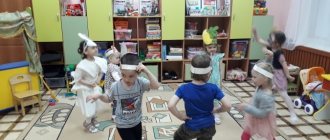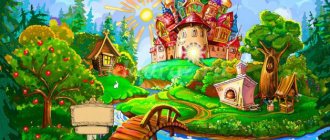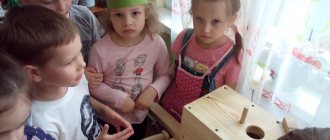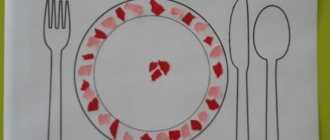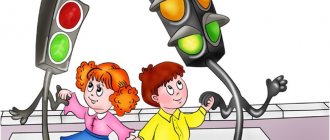Thematic week “Visiting a fairy tale.” Senior group
Topic of the week: “The fairy tale is a lie, but there is a hint in it!
A lesson for a good fellow” for children 5-6 years old Description : this material will be of interest to teachers of senior and preparatory groups, primary school teachers, and mothers of many children. Goal : expanding children's knowledge about Russian folk tales Tasks: - to reveal to children the concepts of “fairy tale”, “folk tale”; - learn to tell fairy tales, retell them by role; — introduce the artist-illustrator of fairy tales Viktor Mikhailovich Vasnetsov; - promote the development of artistry, emotionality, through playing the role of a hero; — cultivate a love for the native language through reading and knowledge of Russian folk tales; - to cultivate an emotional perception of the content of a fairy tale.
MONDAY
Conversation “The fairy tale begins from the beginning, is read to the end, and is not interrupted in the middle”
Goal: teaching the rules of listening to a fairy tale.
Objectives: - clarify and consolidate the understanding of “fairy tale” as a work and as a term; - promote active listening from start to finish without interrupting; - promote the development of logical thinking; - contribute to the development of respect for the narrator, the speaker. Role-playing game: “Book Hospital”
Purpose: teaching to take care of books.
Objectives: - learn to “fix” a “sick” book; — continue to teach how to use scissors correctly and carefully glue; — promote the development of creative abilities; - contribute to the education of accuracy and thrift. Creative activity:
Drawing: “Alyonushka by the Pond” based on the painting by Viktor Mikhailovich Vasnetsov Modeling: “Little Goat”
Theatrical activity:
acting out mini-scenes based on a fairy tale
D/i:
“Which fairy tale is the hero from?”, “Guess the hero”
Art reading:
“ Sister Alyonushka and brother Ivanushka" (magical fairy tale) Reproduction of the painting: "Alyonushka" by Vasnetsov
Work with parents:
"My favorite book of fairy tales": children bring books from home and a mini-library or mini-store is compiled.
TUESDAY Conversation: “Folk tale - magical, about animals, everyday”
Goal: expanding the understanding of a folk tale.
Objectives: - give the concept of “folk”; - to develop knowledge about the division of fairy tales into three types: magical, about animals, everyday; — promote the development of children’s speech activity; — to promote interest in Russian folk art and pride in one’s people. Excursion to the library. Role-playing game “In the Library”
Goal: to introduce children to visiting the library Objectives: - to teach them to play the role of a librarian and reader, to conduct a competent dialogue;
- promote the development of artistry and creative activity; — to promote interest in the library as a home where books live. Creative activity:
Drawing: based on the fairy tale “Crane and Heron” Modeling: “Plate and Jug” Application: “Jug Decoration”
Theatrical activity:
acting out mini-scenes based on the fairy tale Goal: development of artistic abilities.
D/i:
“Describe the hero”
Fiction reading:
“The Crane and the Heron” (a fairy tale about animals) Examination of illustrations for the fairy tale.
Conversation: “Book illustration” Purpose: to familiarize yourself with the concept of “illustration” Work with parents:
please take your children to a bookstore.
WEDNESDAY Conversation “Heroes of fairy tales - what are they?”
Goal: expanding children's knowledge about the character of heroes.
Objectives: - learn to name the distinctive features of heroes, naming positive and negative qualities; - learn to describe actions and explain their meaning; – promote speech development and expansion of children’s vocabulary; - promote the development of correct behavior, a sense of compassion for the weak, and a desire to help. Role-playing game: “Bookstore”
Goal: developing children’s social experience through play activities.
Objectives: - teach how to properly conduct dialogue in a store; - learn to play the roles of seller and buyer; — promote the development of creative abilities; — promote a culture of behavior in the store. Creative activity:
Drawing: depiction of negative and positive characters Modeling: “Pot of Porridge” Application: “Golden Scallop Cockerel”
Theatrical activity:
acting out mini-scenes based on a fairy tale Goal: development of artistic abilities.
D/i:
printed board game “Tale by Tale”, “Which hero does the object belong to?”
Literary reading:
“Porridge from an Axe” (everyday fairy tale), “Flourish Hare”, “Cowardly Hare” and “Brave Hare”, etc.
THURSDAY Conversation “Vasnetsov - artist-illustrator of fairy tales”
Goal: introducing children to illustrators Tasks: - repeat the concept of “illustration”, “artist-illustrator”;
- give the concept of “reproduction”, “picture”; - learn to look at a picture and describe it; — promote the development of children’s speech activity; - promote interest in artistic creativity. Role-playing game: at the request of the children
Goal: development of children's creative activity
Creative activity:
Drawing: based on any of the selected fairy tales Modeling: based on any of the selected fairy tales Application: based on any of the selected fairy tales
Theatrical activity:
acting out mini-scenes based on the fairy tale Goal: development creative and artistic abilities of children.
Fiction reading to choose from:
“The Snow Maiden”, “Ivan Tsarevich and the Gray Wolf”, “Underground Kingdoms”.
Conversation “What do fairy tales teach?”
Goal: generalization and consolidation of acquired knowledge from fairy tales. Objectives: - learn to generalize acquired knowledge;
- promote the development of memory and observation; — to promote the cultivation of love for Russian folk art. Role-playing game: at the request of the children
Goal: development of children's creative activity
Creative activity:
Drawing: plot from a fairy tale to choose from.
Modeling: “Frog” Application: “Swans in the Pond” Theatrical activity:
acting out mini-scenes based on a fairy tale Goal: development of children’s creative and artistic abilities.
D/i:
“Guess the riddle”, assemble a picture from puzzles.
Fiction:
“The Frog Princess” Consideration of Vasnetsov’s reproduction. Throughout preschool age, children love to listen to fairy tales, retell them and write their own. Fairy tales in general contribute to the development of fantasy, imagination, creative thinking, make the child’s world magical, teach kindness and responsiveness, compassion and understanding. Read fairy tales more often! I hope my material will be interesting and useful to all those who work with children.
We recommend watching:
Thematic day in the preparatory group on the topic “Insects” Notes for a mathematics lesson in the senior group “Kolobok’s Journey” Notes on speech development in the senior group “Poultry” Thematic week “Wintering birds” in kindergarten. Second early age group
Similar articles:
Cultivating cognitive interest in social reality in children of senior preschool age
Calendar planning in the senior group “What a delight these fairy tales are!”
Tatyana Vladimirovna Gorbatovskaya
Calendar planning in the senior group “What a delight these fairy tales are!”
This publication is a continuation of the topic “Journey to the Past. How they lived in Rus'." I would be grateful for interesting comments.
1. Examination of illustrations for familiar fairy tales . Goal: to develop the ability to carefully examine illustrations.
2. Physical exercise “Teremok”. Goal: to develop the ability to move in accordance with the text, to learn words.
4. Structural-model activity “Teremok”. Goal: to recall design techniques, develop collective construction, the ability to negotiate and distribute responsibilities.
5. Telling the fairy tale “The Cockerel and the Bean Seed.” Purpose: to discuss the behavior of the characters, to prepare for the dramatization.
6. Reading p. n. With. "Sivka Burka"
Goal: acquaintance with a new
fairy tale , identifying the features of the construction of a fairy tale , comparing it with “Little Red Riding Hood”
.
8. Examination of the painting “Fox in a Sundress.” Purpose: to consolidate knowledge about Russian costume.
9. Examination of illustrations for the fairy tale “Baba Yaga”. Purpose: to find out how the artist conveyed the state of the characters.
10. D/i “Which fairy tale is the hero ?” Goal: remember with children the names of Russian folk tales .
11. Entertainment “Visiting a fairy tale. ” Goal: develop interest in Russian fairy tales , cultivate love for your homeland.
12. Exercise “Recognize the hero of a fairy tale by description ”
(To develop the ability to name the hero
of a fairy tale according to his characteristic features, descriptions, to cultivate self-control).
13. Exercise “Name the heroes of the fairy tale ”
(Teach children to guess
the fairy tale according to the words of the main character, and then name the rest of the heroes of the fairy tale ).
14. D/i “Who Lives Where”
(consolidating knowledge of Russian folk
tales “Teremok”
and
“Zimovye”
, consolidating the concepts of
“domestic and wild animals”
). It is necessary to place the proposed animals in the house and winter quarters.
15. “Name the fairy tale based on the main character ”
(development of reaction speed, activity, independent thinking, learning to name
a fairy tale by character ). Images of fairy tale , children name in which fairy tales they appear . For example: rooster - “Zhikharka”
,
“Zayushkina’s Hut”
,
“Winter Move”
,
“Cat, Rooster and Fox”
, etc.
16. “Tell a fairy tale using illustrations ”
(encourage children to
retell a familiar fairy tale ; create conditions for creative expression)
Children put the pictures in order and tell the content of the fairy tale .
19. "Color the fairy tale "
(to improve children’s ability to color without going beyond the contours, the development of creativity, fine muscles of the fingers).
22. Guessing riddles from fairy tales .
24. Coloring on the theme “ Fairy Tales ”
.
Examination of illustrations for fairy tales by different artists .
25. “Let's tell a fairy tale ” - develop in children the desire and ability to dramatize their favorite fairy tale , convey the character of the characters, their facial expressions, gestures
26. Didactic game “Find out the fairy tale from the illustrations ”
- consolidate knowledge of the content of
fairy tales , develop memory, imagination, thinking, speech.
27. Speech development Topic: “Journey through Russian folk tales ”
Goals: To clarify and enrich children’s knowledge about oral folk art and the works of Russian writers. Learn to recognize a fairy tale by assignment . Learn to convey the structure of a fairy tale using modeling. Enrich children's vocabulary with expressions of verbal politeness. Exercise your ability to guess fairy tales , riddles, and remember the order in which heroes appear in fairy tales . Practice selecting adjectives with the opposite meaning of a noun.
29. Examination of reproductions of paintings by illustrators.
31. Exhibition of books - fairy tales with colorful illustrations containing magical objects
32. Conversation “These wise Russian fairy tales !”
Information and creative project “What a delight these fairy tales are!” (second junior group) Information and creative project “What a beauty these fairy tales are!” Second junior group Developed by teacher: Yakusheva Tamara Vladimirovna.
Long-term project “What a beauty these fairy tales are...” Type of project: creative, long-term. Project participants: preschool teachers, children, parents. Project duration: September 2021 to May 2017. Relevance:.
Summary of a lesson on speech development in the middle group “What a delight these fairy tales are” Summary of a lesson on speech development in the middle group “What a delight these fairy tales” Purpose: to identify the level of grammatical development.
Literary lotto “What a delight these fairy tales are” To play you need: 6 beautifully decorated envelopes with numbers from 1 to 6, a hexagon cube with numbers from 1 to 6, tokens, books for the winners.
Presentation of the creative project “What a delight these fairy tales are!” Presentation of the creative project “What a delight these fairy tales are!” A fairy tale enters a child’s life from a very early age and accompanies them.
Project “What a beauty these fairy tales are...” (second junior group) Project on the topic “What a beauty these tales are. » Fadeeva V.N. Venue: second junior group. Type of project: short-term – duration:.
Entertainment for children of the second junior group “What a delight, these fairy tales!” Goal: creating a joyful mood, a friendly environment for further communication. Program content: Educational objectives:.
Presentation for the lesson “What a delight these fairy tales are!” What fairy tales teach us Fairy tale - folk wisdom What is a fairy tale? What is the difference between a fairy tale and a short story? Who lives in fairy tales? How it begins.
Creative project “What a beauty these fairy tales are!” Creative project “What a beauty these fairy tales are.” Golyanova Svetlana Valerievna, teacher of the highest qualification category, Kopylova Elena.
Source
